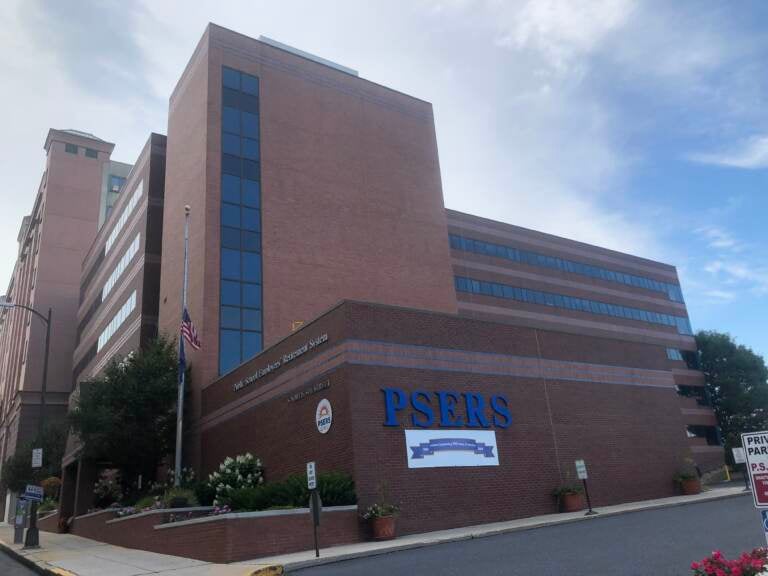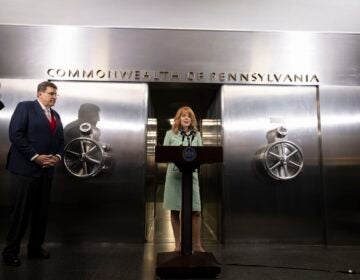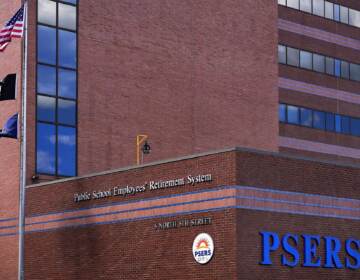Many Pennsylvania state retirees say they can’t afford inflation on their stagnant pensions
Nearly 69,000 former public school and state workers retired before Pennsylvania boosted pension payments two decades ago. Some lawmakers now want to give them an increase.

The PSERS building in Harrisburg. (Handout)
This story originally appeared on Spotlight PA.
When Robert McVay retired from his position as an elementary school principal in Venango County in 1998, he hoped to quietly and comfortably remain in the Pennsylvania community he worked to educate for 30 years.
Instead, McVay, 76, lives in a mobile home in Florida on an annual $27,000 pension that has remained the same since he stopped teaching, despite inflation resulting in a 77% cumulative price increase since 2000, according to the U.S. Bureau of Labor Statistics. McVay’s other source of income is a monthly $1,200 Social Security check.
“The expectation in my mind as I retired was, ‘If I’m careful enough, I can make it off my pension and Social Security,’” McVay said.
That wasn’t so. McVay said when he lived in Pennsylvania, he struggled to afford his electric bills, groceries, and other basic costs. Several years ago, he left for Florida to be closer to his children and pay lower property taxes.
“You would think after serving for a lifetime you would be able to enjoy these final few years, but you can’t,” McVay said.
McVay isn’t the only retiree who is struggling.
Enrollees in Pennsylvania’s two public sector pension funds — the State Employees’ Retirement System (SERS) and the Public School Employees’ Retirement System (PSERS) — haven’t seen a cost of living adjustment, or COLA, since 2004. Nearly 40 other states grant some sort of COLA to retirees.
Particularly hard hit by this lack of a COLA are the almost 69,000 former public school teachers, state government workers, and other public sector employees who retired before 2001, like McVay. On average, these retirees are in their early 80s.
They retired before the legislature increased pension benefits by 25%. The average pension for a SERS enrollee who retired before 2001 is under $15,000 annually, according to the system. That number for a 2022 retiree is more than $30,000, thanks to the increase as well as a rise in average salaries for workers.
There’s a similar gap for PSERS enrollees. A person who worked for 30 years and ended with a $30,000 salary would have a pension of $18,000 if they retired pre-2001, according to Chris Lilienthal, a spokesperson for the Pennsylvania State Education Association. Under the same circumstances, a person who retired post-2001 would have a pension of $22,500.
Two bills making their way through the legislature would provide a major boost to these retirees’ pensions, but concerns about the multibillion dollar price tag could sink their chances in the Republican-controlled state Senate.
A bill introduced by state Rep. Dan Deasy (D., Allegheny) would give state pensioners who retired before July 2001 a COLA ranging from 10% to 20%, with higher percentages for those who have been retired longer.
On average, a SERS retiree would get a $1,600 boost in the first year, while a PSERS retiree’s increase would be $2,175, according to an actuarial note prepared by the Independent Fiscal Office, a state agency.
“We want people to live a dignified retirement,” Deasy said. “Frankly [current pension amounts] are embarrassing, especially as we talk about education and trying to attract and retain teachers.”
Another bill, introduced by state Rep. Steven Malagari (D., Montgomery), is similar to Deasy’s, but proposes higher increases: from 15% to 24.5%. Both bills would pay out the increases over a 10-year period.
The state House’s State Government Committee approved both bills in June.
While Democrats like Deasy have broadly supported some kind of benefit increase, Republicans have argued both pension funds need more money on hand before the commonwealth can consider boosting payments to state retirees.
State Rep. Brad Roae (R., Crawford), minority chair of the House State Government Committee, said in a statement that COLAs are irresponsible given that Pennsylvania “has among the most insolvent public pension plans in the country, and our taxpayers are already paying a lot of money to prop them up.”
In calling the plans insolvent, Rose was referring to the fact that Pennsylvania’s state pensions are underfunded, which means they do not have enough assets to cover the liabilities they owe to pensioners — a situation that could compromise the system’s fiscal sustainability.
In 2015, the systems’ combined deficit was $60 billion. Pew, which tracks pension funds’ fiscal health, has reported that SERS and PSERS have improved in recent years, however.
The Independent Fiscal Office estimated Deasy’s bill would cost about $1.27 billion over 10 years, while Malagari’s would cost around $1.78 billion over the same time period. The cost could go down as pre-2001 pensioners die, which is one of the reasons bill sponsors say they decided to add COLA payments year-over-year as opposed to giving the funds in a lump sum.
The actuarial note prepared by the Independent Fiscal Office estimates that SERS and PSERS will spend more cash than they take in until around 2030 if the legislation is enacted.
Deasy told Spotlight PA the money for COLAs would come from the commonwealth’s general budget fund.
A spokesperson for SERS said that without a dedicated funding stream, COLAs will add to the pension’s unfunded liability. A spokesperson for PSERS declined to comment on the proposed legislation.
Asked about concerns regarding the pension funds’ stability, American Federation of Teachers Pennsylvania President Arthur Steinberg, who has pushed for COLAs, pointed to this year’s roughly $13 billion budget surplus.
“I’m optimistic the legislature will fund this,” Steinberg said. “COLAs are way overdue, critically past the point where some of these folks can survive.”
DaniRae Renno is an intern with the Pennsylvania Legislative Correspondents’ Association. Learn more about the program.
 Spotlight PA is an independent, non-partisan newsroom powered by The Philadelphia Inquirer in partnership with PennLive/The Patriot-News, TribLIVE/Pittsburgh Tribune-Review, and WITF Public Media.
Spotlight PA is an independent, non-partisan newsroom powered by The Philadelphia Inquirer in partnership with PennLive/The Patriot-News, TribLIVE/Pittsburgh Tribune-Review, and WITF Public Media.

Show your support for local public media
WHYY is your source for fact-based, in-depth journalism and information. As a nonprofit organization, we rely on financial support from readers like you. Please give today.






